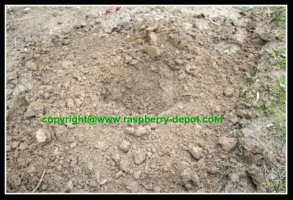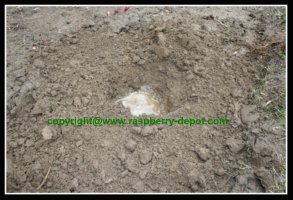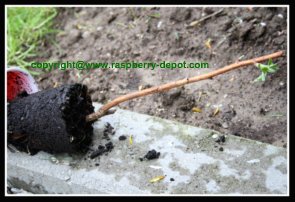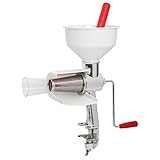Planting Raspberries
How to Plant Raspberry Plants
In the Fall or Spring
Very Simple Instructions for Planting Raspberry Plants the Home Gardener
Are you looking for information about Planting Raspberries?
If you have just purchased raspberry plants for your home garden, here are very simple and basic instructions for how to plant your berry plants.
These step-by-step instructions include how to set up a T-trellis support system for the raspberry bushes and a basic post and wire trellis, if desired.
Raspberries are one of the easiest and most rewarding fruits to grow for the home gardener!
You won't be disappointed with your decision to grow your own raspberries!
*FTC Disclosure: As an Amazon Associate I earn from qualifying purchases with no extra cost to you
*FTC Disclosure: As an Amazon Associate I earn from qualifying
purchases with no extra cost to you
How many raspberry plants do you need?
20 - 25 foot row will supply plenty of fruit for eating fresh and preserving for a family of 4.
When is the best time of the year to plant raspberries?
Although planting raspberries (plants) in the Spring is totally acceptable, the actual preferred time is in the Autumn /Fall.
A loam soil with a high organic matter content is the ideal soil in which to plant raspberries. The site should have good air circulation for disease prevention and full sun.
How to Plant Raspberry Plants - Step-By-Step
Step #1

Dig a hole slightly deeper and wider than the pot/container in which you purchased your plant.
(Depending on the quality of the soil, it may be a good idea to mix well rotted manure/compost into the soil before planting raspberries.)
Step #2

Fill the bottom of the hole with water.
Step #3
If the soil in the container is dry, water the plant to ensure that the soil will not separate from the plant when removing it from the pot.
Carefully remove the plant and the soil surrounding the roots, from the pot, by gently tugging at the base of the plant to release it from the pot. Be sure to keep as much soil attached to the roots as is possible (the root "ball").
Step #4
Place the plant and the root ball into the center of the hole with water, with the top of the soil around the plant about 1" below the ground level. Fill the hole around the plant with soil, and gently tamp the soil around the base of the plant to keep the plant in place.
Step #5
Water the plant well, and continue to water it daily for at least a week, and then every few days, (depending on the weather conditions). To minimize the risk of fungal infection due to wet leaves/canes, water around the plants, trying to keep the majority of the water off the plant itself.
If the weather conditions are very dry, continue to water the newly planted raspberry plants every day. One deep daily watering is better than a few "surface only" watering a day.
Step #6
If you are planting several raspberry plants at one time, space each plant about 1 1/2 feet apart. These are the "mother plants".
Eventually you will notice new growth around these "mother plants". This new growth is often referred to as "suckers".
These suckers will be the plants that will flower and bear the raspberries the following year.
Step #7
You will need to provide a support system for the raspberry plants as they grow.
We find the best method of support for raspberry plants is using a "T-Trellis" System or a Basic Post-and-Wire System. Using one of these two systems will serve to keep the raspberry bushes from sprawling out of bounds and make raspberry picking simple.
To use the "T-Trellis System":
- Drive 7 ft. posts about 18" into the ground, about 12-15 feet apart.
- Fix 2" or 3" diameter cross bars, 2 1/2 feet long to the end post.
- Stretch parallel wires 2 feet apart between the posts, one wire at 3 feet up from the ground, and another one 5 feet up from the ground. (We use clothesline wire - plastic coated steel wire.)
- If desired, stretch additional wires as cross ties every few feet along the wires.
You can achieve a similar result using 2 sturdy 7 foot posts (Basic Post-And-Wire Trellis) placed about 2 1/2 feet apart at each end of the row. Then tie the parallel wires to it at the intervals used above.
It is also possible to purchase trellis systems from *Amazon.com.
Click on the images below for more detailed product information and customer reviews.
As the plants grow wider and taller, carefully guide the branches between the parallel support wires.
Suckers which grow too far outside of the raspberry row(s) should be transplanted, pruned out, or mowed over and removed.
Transplanting raspberry plants is a great way to increase the size of your raspberry patch! No need to purchase plants, simply transplant your own!
GO to Transplanting/Dividing/Propagating Red Raspberry Plants
GO to How to Propagate/Transplant Black and Purple Raspberry Plants
Keeping the widths of the rows of bushes about 1 /2 - 2 feet wide is important to keep a neat and well maintained row.
Do not allow the raspberry bushes to grow "wild", without guiding them back to the support system.
It is much easier to care for a tidy raspberry patch, and your raspberry plants will stay healthier if the plants are trained using a support system. This organization will help to keep away unwanted pests and disease by allowing proper air flow to the raspberry bushes.
ENJOY your Raspberry Gardening!
For more detailed information about growing raspberry plants, here below, (or use the navigation bars) are links to pages which will be helpful in your berry growing endeavours!
TRANSPLANTING Raspberries
(Propagating/Dividing)
Raspberry Plant CARE
(Fertilizing/Watering/Spraying/Sun Requirements)
TOP of Planting Raspberries
HOME to Raspberry-Depot.com Homepage
©2010-2024 Raspberry-depot.com - All Rights Reserved Worldwide
No Reproduction Permitted Without
the Express Written Consent of the Site Owner
★ Please Visit ★
My "Sister" Sites:
Rhubarb Recipes
Apple Recipes
Special Occasion Recipes
♥ Valentine Recipes ♥
Pancake Day Recipes
Easter Recipes
Mother's Day Recipes
Father's Day Recipes
Thanksgiving Recipes
Christmas Recipes
New Year's Eve Recipes

This Knife Sharpener
is one of the
Most USEFUL
Kitchen
Tools
that I have
EVER
Purchased
I've been using
the same
Knife Sharpener as
the One Below for
Well Over 10 Years!
⇩















